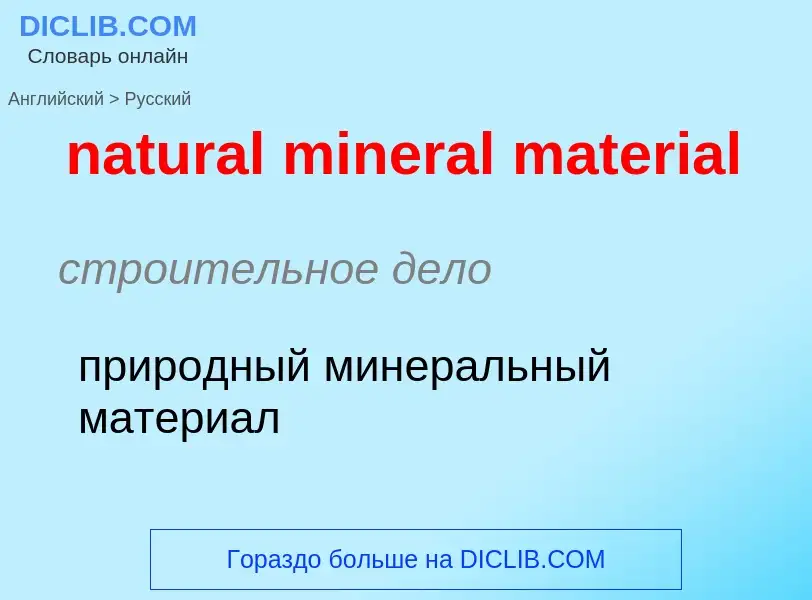Перевод и анализ слов искусственным интеллектом ChatGPT
На этой странице Вы можете получить подробный анализ слова или словосочетания, произведенный с помощью лучшей на сегодняшний день технологии искусственного интеллекта:
- как употребляется слово
- частота употребления
- используется оно чаще в устной или письменной речи
- варианты перевода слова
- примеры употребления (несколько фраз с переводом)
- этимология
natural mineral material - перевод на русский
строительное дело
природный минеральный материал
строительное дело
природные минералы
['min(ə)rəl]
общая лексика
вазелиновый
минерал
минеральный
нефтегазовая промышленность
минеральное сырьё
прилагательное
общая лексика
минеральный
химия
неорганический
существительное
['min(ə)rəl]
общая лексика
минерал
руда
полезные ископаемые
разговорное выражение
mineral waters
собирательное выражение
минеральная вода
общая лексика
ископаемые полезные
геология
ископаемые минеральные
машиностроение
сырье минеральное
Определение
Википедия
In geology and mineralogy, a mineral or mineral species is, broadly speaking, a solid chemical compound with a fairly well-defined chemical composition and a specific crystal structure that occurs naturally in pure form.
The geological definition of mineral normally excludes compounds that occur only in living organisms. However, some minerals are often biogenic (such as calcite) or are organic compounds in the sense of chemistry (such as mellite). Moreover, living organisms often synthesize inorganic minerals (such as hydroxylapatite) that also occur in rocks.
The concept of mineral is distinct from rock, which is any bulk solid geologic material that is relatively homogeneous at a large enough scale. A rock may consist of one type of mineral, or may be an aggregate of two or more different types of minerals, spacially segregated into distinct phases.
Some natural solid substances without a definite crystalline structure, such as opal or obsidian, are more properly called mineraloids. If a chemical compound occurs naturally with different crystal structures, each structure is considered a different mineral species. Thus, for example, quartz and stishovite are two different minerals consisting of the same compound, silicon dioxide.
The International Mineralogical Association (IMA) is the generally recognized standard body for the definition and nomenclature of mineral species. As of March 2023, the IMA recognizes 5,914 official mineral species.
The chemical composition of a named mineral species may vary somewhat by the inclusion of small amounts of impurities. Specific varieties of a species sometimes have conventional or official names of their own. For example, amethyst is a purple variety of the mineral species quartz. Some mineral species can have variable proportions of two or more chemical elements that occupy equivalent positions in the mineral's structure; for example, the formula of mackinawite is given as (Fe,Ni)
9S
8, meaning Fe
xNi
9-xS
8, where x is a variable number between 0 and 9. Sometimes a mineral with variable composition is split into separate species, more or less arbitrarily, forming a mineral group; that is the case of the silicates Ca
xMg
yFe
2-x-ySiO
4, the olivine group.
Besides the essential chemical composition and crystal structure, the description of a mineral species usually includes its common physical properties such as habit, hardness, lustre, diaphaneity, colour, streak, tenacity, cleavage, fracture, parting, specific gravity, magnetism, fluorescence, radioactivity, as well as its taste or smell and its reaction to acid.
Minerals are classified by key chemical constituents; the two dominant systems are the Dana classification and the Strunz classification. Silicate minerals comprise approximately 90% of the Earth's crust. Other important mineral groups include the native elements, sulfides, oxides, halides, carbonates, sulfates, and phosphates.

![[[Aegirine]], an iron-sodium clinopyroxene, is part of the inosilicate subclass. [[Aegirine]], an iron-sodium clinopyroxene, is part of the inosilicate subclass.](https://commons.wikimedia.org/wiki/Special:FilePath/Aegirine-233494.jpg?width=200)

![[[Asbestiform]] [[tremolite]], part of the amphibole group in the inosilicate subclass [[Asbestiform]] [[tremolite]], part of the amphibole group in the inosilicate subclass](https://commons.wikimedia.org/wiki/Special:FilePath/Asbestos with muscovite.jpg?width=200)
![Perfect basal cleavage as seen in [[biotite]] (black), and good cleavage seen in the matrix (pink [[orthoclase]]). Perfect basal cleavage as seen in [[biotite]] (black), and good cleavage seen in the matrix (pink [[orthoclase]]).](https://commons.wikimedia.org/wiki/Special:FilePath/Biotite-Orthoclase-229808.jpg?width=200)
![[[Galena]], PbS, is a mineral with a high specific gravity. [[Galena]], PbS, is a mineral with a high specific gravity.](https://commons.wikimedia.org/wiki/Special:FilePath/Calcite-Galena-elm56c.jpg?width=200)
![radioactive]] [[uranium]]-bearing mineral. radioactive]] [[uranium]]-bearing mineral.](https://commons.wikimedia.org/wiki/Special:FilePath/Carnotite-201050.jpg?width=200)



![Sphalerite crystal partially encased in [[calcite]] from the [[Devonian]] [[Milwaukee Formation]] of [[Wisconsin]] Sphalerite crystal partially encased in [[calcite]] from the [[Devonian]] [[Milwaukee Formation]] of [[Wisconsin]]](https://commons.wikimedia.org/wiki/Special:FilePath/Geodized brachiopod.jpg?width=200)

![Pink cubic [[halite]] (NaCl; halide class) crystals on a [[nahcolite]] matrix (NaHCO<sub>3</sub>; a carbonate, and mineral form of sodium bicarbonate, used as [[baking soda]]). Pink cubic [[halite]] (NaCl; halide class) crystals on a [[nahcolite]] matrix (NaHCO<sub>3</sub>; a carbonate, and mineral form of sodium bicarbonate, used as [[baking soda]]).](https://commons.wikimedia.org/wiki/Special:FilePath/Halite-Nahcolite-51411.jpg?width=200)
![[[Hübnerite]], the manganese-rich end-member of the [[wolframite]] series, with minor quartz in the background [[Hübnerite]], the manganese-rich end-member of the [[wolframite]] series, with minor quartz in the background](https://commons.wikimedia.org/wiki/Special:FilePath/Hubnerite-Quartz-216455.jpg?width=200)
![twinning]] common in orthoclase. twinning]] common in orthoclase.](https://commons.wikimedia.org/wiki/Special:FilePath/Kaolinite-Orthoclase-lw18c.jpg?width=200)

![[[Natrolite]] is a mineral series in the zeolite group; this sample has a very prominent acicular crystal habit. [[Natrolite]] is a mineral series in the zeolite group; this sample has a very prominent acicular crystal habit.](https://commons.wikimedia.org/wiki/Special:FilePath/Natroliteinde1.jpg?width=200)
![[[Pyrite]] has a metallic lustre. [[Pyrite]] has a metallic lustre.](https://commons.wikimedia.org/wiki/Special:FilePath/Pyrite 2.jpg?width=200)




![[[Topaz]] has a characteristic orthorhombic elongated crystal shape. [[Topaz]] has a characteristic orthorhombic elongated crystal shape.](https://commons.wikimedia.org/wiki/Special:FilePath/Topaz-235220.jpg?width=200)
